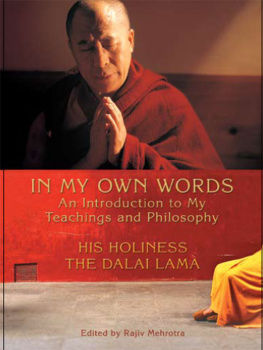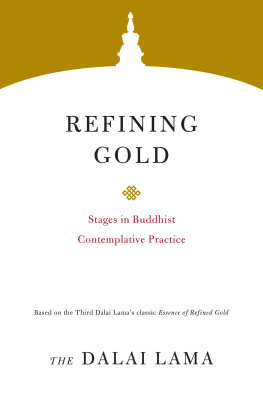THE LIBRARY OF WISDOM AND COMPASSION
The Library of Wisdom and Compassion is a special multivolume series in which His Holiness the Dalai Lama shares the Buddhas teachings on the complete path to full awakening that he himself has practiced his entire life. The topics are arranged especially for people not born in a Buddhist culture and are peppered with the Dalai Lamas own unique outlook. Assisted by his longterm disciple, the American nun Thubten Chodron, the Dalai Lama sets the context for practicing the Buddhas teachings in modern times and then unveils the path of wisdom and compassion that leads to a meaningful life and a sense of personal fulfillment. This series is an important bridge from introductory to profound topics for those seeking an in-depth explanation in contemporary language.
Wisdom Publications
199 Elm Street
Somerville, MA 02144 USA
wisdompubs.org
2017 Dalai Lama and Thubten Chodron
All rights reserved.
No part of this book may be reproduced in any form or by any means,
electronic or mechanical, including photography, recording, or by any
information storage and retrieval system or technologies now known
or later developed, without permission in writing from the publisher.
Library of Congress Cataloging-in-Publication Data
Names: Bstan-dzin-rgya-mtsho, Dalai Lama XIV, 1935 author. | Thubten Chodron, 1950
Title: Approaching the Buddhist path / Bhiku Tenzin Gyatso, the Fourteenth Dalai Lama and Bhikui Thubten Chodron.
Description: Somerville, MA: Wisdom Publications, 2017. | Series: The library of wisdom and compassion; Volume 1 | Includes bibliographical references and index.
Identifiers: LCCN 2016053409 print) | LCCN 2017017596 (ebook) | ISBN 9781614294412 (pbk.: alk. paper) | ISBN 1614294410 (pbk.: alk. paper) | ISBN 9781614294573 (ebook)
Subjects: LCSH: Buddhism Doctrines.
Classification: LCC BQ7935.B774 A77 2017 (ebook) | LCC BQ7935.B774 (print) | DDC 294.3 dc23
LC record available at https://lccn.loc.gov/2017017596
ISBN 978-1-61429-441-2 ebook ISBN 978-1-61429-457-3
21 20 19 18 17
5 4 3 2 1
Cover and interior design by Gopa & Ted2, Inc. Set in Diacritical Garamond Pro 11/14.6.
Photo credits: p. xii, Stephen Cysewski; pp. 16, 146, Olivier Adam; p. 170, Konstantin Sutyagin; p. 190 (top), Dennis Jarvis; p. 190 (bottom), Zhong Feng; p. 230, Roberto Dutesco; p. 246, Kevin K. Cheung. All photos reprinted with permission.
This book was produced with environmental mindfulness. For more information, please visit wisdompubs.org/wisdom-environment.
Publishers Acknowledgment
The publisher gratefully acknowledges the generous help of the Hershey Family Foundation in sponsoring the production of this book.
Prologue
T HE WORLD WE LIVE IN is very different from the world at the Buddhas time, yet we human beings have the same afflictions and still experience physical and mental suffering. While the truth of the Buddhas teachings transcends historical eras, the way they are presented to practitioners in a given time is influenced by the specific culture, environment, and economic and political challenges. I encourage us to become twenty-first-century Buddhists people whose view is rooted in the Buddhas message of compassion and wisdom and who also have a broad understanding of many fields, such as science especially neurology, psychology, and physics and other religions.
Our Buddhist knowledge must be expansive, not limited to just one topic, practice, or Buddhist tradition. We should try to learn about the teachings and practices of other Buddhist traditions and understand how they suit the particular dispositions and interests of the people who practice them. We may also include some of these teachings in our own practice. In this way, we will better appreciate the Buddhas skill as a teacher, which will reduce the sectarianism that limits us Buddhists from acting together to contribute to the welfare of all peoples and environments on our planet. We should also understand the full path to awakening and how different teachings can be practiced by the same individual at different points of his or her spiritual journey. This will clarify our personal practice as well as increase our respect for all Buddhist traditions and other religions.
To grow these understandings in ourselves, reciting prayers and mantras is not sufficient. While perhaps increasing our devotion, these activities alone do not bring wisdom. In the modern world, we need to be realistic and practical, and for this, knowledge is essential. All of us want happiness, not suffering. Since both happiness and suffering arise in dependence on causes and conditions, we must know the causes of each so that we can train our minds to create the causes for happiness and abandon the causes for suffering.
All of us want a harmonious society. Since society consists of individuals, to bring about peace each individual must cultivate peace in his or her own heart and mind. Of course the ultimate aim of the Buddhas teachings goes beyond world peace to liberation from all rebirth in cyclic existence (sasra), but the teachings can help us to create a more peaceful society while we are still in cyclic existence.
The material in this series accords with the general presentation of the Indian sages of the Nland tradition, who are held in esteem by all four Buddhist traditions in Tibet as well as Buddhist traditions in China. Most of the quoted passages come from these Indian sources, and in terms of the method aspect of the path renunciation, bodhicitta, and the perfections of generosity, ethical conduct, fortitude, joyous effort, and meditative stability there is little difference among them. Tibetan traditions follow Ngrjuna and speak of the noncontradictory nature of emptiness and dependent arising as the essence of the wisdom aspect of the path, here we will emphasize Tsongkhapas presentation of emptiness and sometimes mention teachings from the Nyingma, Kagyu, and Sakya traditions. Because the Pli tradition emphasizes the Fundamental Vehicle which is common to all Buddhist traditions, we also cite passages from it.
In general, my teaching style does not follow the approach of the traditional lamrim (stages of the path) teachings. I like to speak a lot about emptiness and show its relationship to other aspects of the path; this way of presenting the teachings also flourished in ancient India. Many years ago, His Eminence Geshe Lungrik Namgyal, the Gaden Tripa at that time, said to his friends, Understanding His Holiness the Dalai Lamas teachings is challenging because his way of presenting the material is special. He touches on this point and that, but we are unable to integrate everything into the traditional framework of the teachings. I wonder if this is praise or criticism. In any case, please think deeply about the various topics in the manner explained. Contemplate how these topics relate to one another and to your life.
Bhiku Tenzin Gyatso, the Fourteenth Dalai Lama
Thekchen Choling

Preface
The Purpose of This Series
E VERYTHING COMES ABOUT due to causes and conditions, and this series is no exception. Explaining some of its causes and conditions will help you understand the purpose of this series. Its ultimate purpose is to lead you, the reader, and other sentient beings to full awakening. Although many excellent works on the stages of the path, the lamrim, already exist, there is a need for this unique series. To explain why, I will share a little of my personal story, which is typical of the first generation of Westerners encountering Tibetan Buddhism.
Next page














